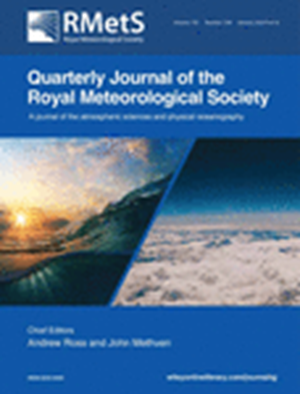Convergence of ensemble forecast distributions in weak and strong forcing convective weather regimes
IF 3
3区 地球科学
Q2 METEOROLOGY & ATMOSPHERIC SCIENCES
引用次数: 0
Abstract
The constraint of computational power and the huge number of degrees of freedom of the atmosphere means a sampling uncertainty exists in probabilistic ensemble forecasts. In our previous study, the uncertainty could be quantified, creating a convergence measure which converges proportional to in the limit of large ensemble size . This power law can then be extrapolated to determine how sampling uncertainty would decrease with larger ensemble sizes and hence find the necessary ensemble size. It is unknown, however, how the sampling uncertainty depends on different weather regimes. This study extends the previous idealised ensemble developed, by including weak and strong forcing convective weather regimes, to look at how sampling uncertainty convergence differs in each. Two ‐member ensembles were run, with weak and strong forcing respectively. Comparisons with a kilometre‐scale weather prediction model ensured realistic weak and strong forcing regimes by comparing the rain, convective available potential energy (CAPE), convective adjustment timescale, and distribution shapes throughout the diurnal cycle. Differences in distribution shape between the regimes led to differences in the convergence measure. Large differences in spread between weak and strong forcing runs throughout the hr period led to large differences in sampling uncertainty of the mean and standard deviation, which could be quantified according to well‐known equations. The timing of these differences was case‐dependent. For extreme statistics such as the quantile and for cases where there was precipitation, the moisture variables for the weak forcing case had the largest sampling uncertainty and required the most members for convergence proportional to . This was due to the tails of the weak forcing moisture variables containing the least amount of density. Different ensemble sizes will hence be required depending on whether one is in the weak or strong forcing convective weather regime.弱和强强迫对流天气系统中集合预报分布的收敛性
计算能力的限制和大气的巨大自由度意味着概率集合预测中存在采样不确定性。在我们之前的研究中,可以对这种不确定性进行量化,建立一个收敛度量,在大集合规模的限制下,收敛度与大集合规模成正比。根据这一幂律可以推断出采样不确定性如何随着集合规模的增大而减小,从而找到必要的集合规模。不过,目前还不知道采样不确定性如何取决于不同的天气状况。本研究扩展了之前开发的理想化集合,纳入了弱和强对流天气体制,以研究取样不确定性在每种天气体制下的收敛有何不同。研究人员分别运行了具有弱和强强迫的两个成员集合。通过比较雨量、对流可用势能(CAPE)、对流调整时间尺度和整个昼夜周期的分布形状,与千米尺度天气预报模式进行比较,确保弱和强强迫天气体制符合实际情况。两套模式在分布形状上的差异导致了收敛性测量结果的不同。在整个昼夜周期内,弱强迫和强强迫运行之间的分布差异很大,导致平均值和标准偏差的采样不确定性差异很大,这可以根据著名方程进行量化。这些差异出现的时间取决于具体情况。对于量值等极端统计量和有降水的情况,弱强迫情况下的水汽变量具有最大的采样不确定性,需要最多的成员才能收敛。 这是因为弱强迫水汽变量的尾部含有最少的密度。因此,不同的对流天气系统需要不同规模的集合,这取决于是在弱对流天气系统还是在强对流天气系统中。
本文章由计算机程序翻译,如有差异,请以英文原文为准。
求助全文
约1分钟内获得全文
求助全文
来源期刊
CiteScore
16.80
自引率
4.50%
发文量
163
审稿时长
3-8 weeks
期刊介绍:
The Quarterly Journal of the Royal Meteorological Society is a journal published by the Royal Meteorological Society. It aims to communicate and document new research in the atmospheric sciences and related fields. The journal is considered one of the leading publications in meteorology worldwide. It accepts articles, comprehensive review articles, and comments on published papers. It is published eight times a year, with additional special issues.
The Quarterly Journal has a wide readership of scientists in the atmospheric and related fields. It is indexed and abstracted in various databases, including Advanced Polymers Abstracts, Agricultural Engineering Abstracts, CAB Abstracts, CABDirect, COMPENDEX, CSA Civil Engineering Abstracts, Earthquake Engineering Abstracts, Engineered Materials Abstracts, Science Citation Index, SCOPUS, Web of Science, and more.

 求助内容:
求助内容: 应助结果提醒方式:
应助结果提醒方式:


